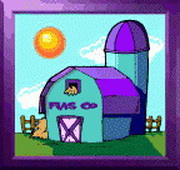White Wash
We first started white washing the inside of our barn because the barn was so dark. We thought the white wash would brighten things up, and we were right. The white wash gives the barn a real "neat and clean" feel, and so, we like to white wash at kidding time to create a nice showcase for the new kids we have for sale. We've also white washed the milk room which now feels much lighter, brighter and cleaner.
Before our does start kidding, Larry cleans out the stalls and gives the flooring a good bleach wash, and then we give all the other surfaces a coat of white wash. The white wash coats these surfaces with an alkaline layer that discourages the growth of many bacteria, so we believe it helps get the goat babies off to a good healthy start to life.
White wash is very inexpensive to make and is fairly harmless to goats. Goldie, our big LaMancha doe, not known for her brains, actually likes to drink it (though we try not to let her) and many of the goats lick it off the walls. We have never had a goat get sick from white wash, so we don't worry about it. The goats will also wear the wash off when they rub on it, so be prepared to re-coat every year or so. But remember, it's not paint, and it's only a barn, so you can really just slop it on.
To make your own white wash, you need lime. There are two kinds of lime you can buy so be sure you get the right kind: hydrated lime, which is pure white. It is also called slake lime, builder's lime, or mason's lime (the old timers at our feed store incorrectly call it "burnt lime"- DO NOT use burnt lime). Hydrated lime is also very caustic, so the bag will have a warning on it. The other kind of lime is light gray and is the kind we use to spread on our barn floor. It is called "ag lime", "garden lime", "barn lime" or dolomite. Do not spread hydrated lime on your barn floor. Why do we spread lime on our barn floor? It provides that antibacterial quality, dries out, "sweetens" the floor , and Larry says it makes it easier to clean.
Please, remember that when handling hydrated lime and preparing the white wash not to breathe the dust from the lime and to wear gloves. I learned the hard way about the gloves (I hate wearing gloves). The lime will ravage bare hands. If you do get the wash on your hands it's a good idea to rub your hands with vinegar; the acid in the vinegar counter acts the alkaline in the lime. Larry says a little Bag Balm later helps too. Barn lime on the other hand is not as caustic and you can handle it with your bare hands without worry.
Notes about this whitewash:
- It will wash off over time if exposed to rain.
- This is "authentic white wash" and is not paint and is not permanent: rubs off and sometimes flakes off over time.
- If you lean against a white washed wall you will end up with white on your clothes.
- I do not recommend this for home decorating use.
- It is safe to use inside barns and is not harmful to small animals.
White Wash
Mix in a large bucket, a five gallon paint bucket is ideal:
- 3 large coffee cans of hydrated lime (about 12 cups)
- 1 pound or 1 small coffee can of salt (about 4 cups)
- 2 gallons of water
When you mix this together, mix a little lime/salt, then a little water, then a little lime, etc. It you just dump it all together it's like stirring boat anchor. You should let the mixture sit over night, but we usually just use it right away and have had no problems. The white wash should be fairly watery, remember it's a wash, not a paint. Give it a stir once and a while as you use it.
To use the white wash, just get a big brush and slop it on. Don't worry about getting it on your clothes, it washes out very easily. It may seem like it's not covering very well as you paint it on, especially on new pine 2x4s, but it will whiten up considerably when it's completely dry, be patient.
In no time at all, you'll have a brighter and fresher environment for you and your goats.
Home / Full PageNote:
I have been told you can improve this white wash recipe by adding about a tablespoon of powdered alum per gallon of whitewash. This supposedly will improve it's "sticking" characteristics, i.e., makes it more resistant to rubbing off. I have not tried this and do not know if it helps or not.
I was also told by the same source that, to really make it last -- get some hide glue flakes. Dissolve about 1/2 a pound of glue flakes in enough boiling water to dissolve thoroughly and add it the recipe (with alum added). This supposedly reduces the frequency of re-whitewashing at minimal additional expense. I have not tried this and do not know if it helps or not.
If one is concerned about the animal content of glue, it's supposed to work with goat milk. I have not tried this and do not know for sure.
